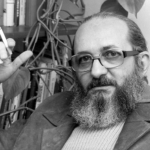Women create safe spaces to free their creativity
Feminist graphic artists and musicians are joining collectives that aim to challenge patriarchal power.
Author:
4 December 2018

“Structures!” sighs Mpumi Mathabela, co-ordinator of the Feminist Women’s Art Network. “Structures come from donors — they’re part of all that registration red tape. The only thing you can do is be aware of the power relations, and create a working space where power in decision-making is constantly challenged.”
The art network (a component of the OneinNine Campaign) operates out of a new workspace on the edge of Johannesburg’s Maboneng Precinct. Huge mural banners, rolls of paper, paints and brushes, books, printed T-shirts and mugs are propped between and around the desks. “Women will smash patriarchy,” reads one, the words twining through a graphic of strong women joyously stomping the many-headed monster.
The crowded industrial space feels a long way, in more than miles, from a lush, shady garden in the suburb of Melville and an airy, two-piano drawing room where composer Clare Loveday is introducing a Sunday afternoon recital.
But it’s not really so distant. Because the recital – with a programme embracing everything from the Baroque-era song of Purcell to the modern original maskandi of Thobekile Mbanda – is the first Johannesburg event for the Women’s Music Collective. Loveday is equally wary of replicating dominant power structures. She quotes Wits professor Shireen Hassim: “You don’t lead a collective. You wait for it to gather its own momentum,” later adding, “The direction has to come from within.”
Each group came, by its own path, to the same two conclusions: safe spaces were needed to free women’s creativity; and collectives were the best model.
Advocacy art
The art network, says Mathabela, was “born in fire”. Its organisational context, the OneinNine Campaign, was sparked by the 2006 Zuma rape trial, “so the political issues were upfront from the start.” OneinNine’s Carrie Shelver brought the group together with the Curriculum Development Project (CDP) under the late Charlotte Schaer to develop campaign materials.
CDP’s philosophy – Art as Advocacy – drew on Paulo Freire’s Pedagogy of the Oppressed and the experience of visual artists in South African and other liberation struggles. Out of that shared campaigning, says Mathabela, came art-making for and with other like-minded organisations. This united gender-nonconforming women from diverse contexts, and the dream of a space “where women can just come together and create, unconfined by commercial or patriarchal pressures” grew.
Related article:
Mathabela describes herself as “just a random creative person” who “fell in love with graphics” in those early classes, shadowed silkscreen printer Mike Nicolaides to learn the skills, briefly ran her own silk-screening business, and co-ordinated what coalesced as the Advocacy Media Production Studio (AMPS). AMPS drew training from Nicolaides on printing and artist Judy Seidman on messaging, and the Feminist Women’s Art Network was formally established in late 2016.
“The decision to be a collective,” she says, “came right at the start. There’s strength in putting women together in a room. It’s that sharing of experiences that makes us experts.”
Free of male instruction
Loveday is an internationally established composer with multiple projects to her name, including a multimedia collaboration with visual artist Nandipha Mntambo. Her decision to seek partners for a women’s music collective just over a year ago came after “one too many experiences of absolutely horrifying sexism…that all-too-familiar barking order in the pack; dismissive and woman-blaming comments about sexual abuse,” at a composers’ meeting.
“I thought: never again. But rather than me shouting at one individual one more time, there’s strength in numbers. We need a community.”
Related article:
As she talked with other women she knew – Hassim, Ceri Moelwyn-Hughes who has researched women in music, pianist Coila Enderstein, and many more – stories of gender harassment and stereotyping piled up from what outsiders might imagine as a genteel, sheltered concert and composing world. A 2017 Africa Open seminar opened the initiative to more young women, contributing more diverse musical practices and experiences.
“The responses weren’t what I expected,” says Loveday. “I expected a need for non-discriminatory opportunities and access, and of course that was mentioned. But the big message was: we need space to bounce ideas around, try new things and be ourselves without male instruction.
“And that’s often what it’s like in music schools. The Big Men love to instruct young women, but really don’t like it when the women become ‘big’ themselves…”
Learning collectively
For both collectives, financial survival is never going to be easy. The composers have so far concentrated on pooling the resources in kind they control. The concert was in a member’s home; logistics were supported by Betwixt Music, organisers of experimental music and also members. The visual artists need a counterweight to dependence on those hierarchy-demanding donors, so AMPS continues making progressive art objects such as T-shirts, badges and coffee mugs, which provide an additional income stream. “It’s little,” says Mathabela, “but it’s a pot we can draw on. We’ve had to be creative. We’re working with women who are often unemployed with no income. Theirs is the input we need most – but sometimes a woman can’t afford even to get a taxi to a class.”
The visual artmaking has grown over the years. There has been work across southern Africa (Botswana, Zimbabwe and Kenya) and a 2016 mural-painting collaboration in Hillbrow with India’s feminist Fearless Collective and HOLAA Africa. Making graphics has expanded into photography, learning podcasting, and sessions involving other creatives such as poets. “We need to foster synergy with the rest of Africa,” says Seidman, “and collaborations like the one with Fearless give us a chance to build experience from existing political collectives elsewhere.”
Checking privilege
For the much younger WMC, says Loveday, “we’ll continue building slowly to develop a more public face through more performances and other events. Our Facebook group is growing and buzzing and [member and composer] Nicola du Toit has engaged UCT on why their gallery of South African jazz composers contains not a single woman… A huge question for us to tackle is why there are so few young black women composers. We started as a group of predominantly older white women and we have to constantly check our privileges of age, race, resources – and simply confidence.
“For me, it was encouraging that the concerts (there was a second in Cape Town) reflected a far broader constituency of women musicians, where age and genre simply didn’t matter.”
Mbanda, who performed traditional and original new songs in Melville, is distressed that although there are many women traditional composers – “they’re all in their 60s and 70s. And their grandchildren can barely even identify the instruments.” One song she wrote was about lobola: “Culture is keeping people who love one another apart”.
“You used to hear maskandi in Jeppe Park – that’s closed down. Where are they now? It seems like people with no money are being shut out of even the simple pleasure of making music.” Mbanda dreams of performing her lobola song “in a pop-up gig at the Bree St taxi rank. That’s the audience it’s written for…halfway through, my amp might be gone, but the audience won’t be lost about what it means.”
Power from difference
Sustaining the diversity of people and ideas that united traditional music like hers with classical and avant-garde at that concert in Melville needs effort. Loveday believes the WMC is a feminist project by its very nature, “but to put that in a title would need a collective decision; mention the F-word and some people run away.”
The art collective has already met those dilemmas. Solutions are tough, but not complex. “You talk,” says Mathabela. “And talk. We challenge and argue for a long time so we can scrutinise all the art we make with respect and love. Supporting one another has to be built into your collective process… If you’ve identified together that women need a safe space to create, you’ve already taken an important stand against patriarchy. Even if the collective members have differences, that’s not a reason to disband. There’s also power in those differences.”


